
“Turn” is an AMC cable series set in the American Revolution in New York. The series purports to tell the story of America’s first spy ring. It was based in Setauket, Suffolk County. The fidelity of the TV series to history is not the issue of this post. That subject has been addressed elsewhere and by others. Rather the focus is on tourism and the squandered opportunity by New York State.
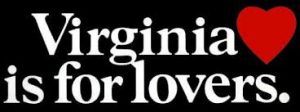
The history roundtable on May 29, 2014, in Albany, was convened by State Legislator Steve Englebright of Setauket. He began the meeting by expressing his disgust about the TV series set in his home town being filmed in Virginia. Worse was the state of Virginia advertised on the show inviting viewers to come to Virginia to see where the American Revolution happened. So here we had a situation where Virginia was leveraging an American Revolution show set in New York to promote tourism in Virginia while New York did nothing. I will leave it to your imagination to choose the words to characterize the performance of New York State in this matter.
The story gets even worse. Towards the end of the third season, the locale of the show shifted. SPOILER ALERT: Benedict Arnold is a traitor and John André is captured and hanged. All these events happened in the Hudson Valley, a region full of American Revolution sites and signs. Part of the presentation on the show was historically laughable:
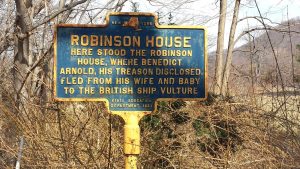

Beverly Robinson House (Garrison Union Free SD) Arnold’s Flight (Robyn Luzon)
- Benedict Arnold did not live at West Point. He lived in the Beverly Robinson home on the east side of the Hudson in Garrison, Putnam County. Little remains of the house save for a root cellar. I have been there with the teachers and the current owners of the property invited us into their home. There is, of course, a NYS history sign to mark the site.
- Arnold fled to the Hudson River to make his escape. There is another history sign on the opposite side of Route 9D in Putnam marking the start of his escape route. In the TV show, Arnold is shown on a waterway representing the Hudson. It looks more like the creek Sheriff Taylor took Opie fishing. There is none of the majesty of the Hudson nor the S-curve, the choke point where a chain was placed across the river from the western point (hence the name “West Point”) to Constitution Island.
- Washington and the captured Andre are shown living in tents in the open field. In fact, Washington stayed at The DeWint House aka George Washington’s Headquarters, Masonic Historic Site, in Tappan, Rockland County. Far from being held prisoner in a tent, André was ensconced in good officer tradition in the 76 House. I have been with the teachers to both locations and enjoyed several meals in the still-operating restaurant.
- The hanging did not occur in the open field ether as depicted in the show.
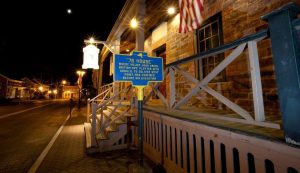

76 House and the monument to the hanging (Rolf Müller)
One can understand the logistical advantages of not filming on location but still the publicity opportunities to showcase these tourist locations should be obvious to anyone with some exceptions.
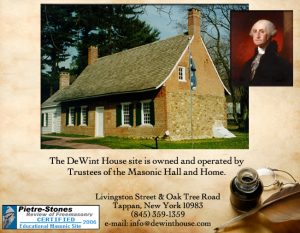
I mentioned this deplorable condition to someone from AMC during a panel discussion at the New-York Historical Society last spring. I gave the person my card and was told it would be referred to the appropriate person within AMC. Naturally nothing happened.
The story gets even worse. Guess what took place in the middle of these two episodes on “Turn” where André is caught and hanged — that’s right, the Path through History weekend. The event celebrating New York history was smack in the middle of two nationally-shown episodes about events in New York history of national importance. It’s almost as if AMC went out of its way to mock the Path project. Only Virginia chose to advertise its American Revolution sites during these shows.
The story gets even worse. As is well known, New York State provides no staff or funding to develop paths through history. To compensate for New York’s failure to support the Path program, last year I recommended that the history community submit requests for “Pathfinders” in the REDC funding process.
These people would then do what should have been done for years. Their job would be to create itineraries which could be offered to tour operators as “shovel-ready” tours. Priscilla Brendler, executive director of the Greater Hudson Heritage Network (GHHN), the organization which actually handles the Path weekend program, responded to my suggestion by submitting exactly such a proposal to the Mid-Hudson REDC, the region where these “Turn” episodes were set. Meghan Taylor, the Regional Director for the Mid-Hudson Region, previously had meet with the regional history community at my initiative, was receptive. The Pathfinder application was approved at the regional level and submitted to Albany.
Guess what. There was no funding line appropriate for the request. Remember all the times how New York State talks the talk of collaboration and cooperation. Now when a grassroots application was submitted to create exactly such collaboration and cooperation among history sites, there was no bucket into which the application could be placed. Not only is there no staff or funding for state bureaucrats to develop paths on a fulltime basis, there is no funding either to support such efforts by the history community itself. The application was denied. The next time anyone from New York State talks about collaboration and cooperation, say SHOW ME THE MONEY!
The story gets even worse. The Path project is intended to generate revenue especially from sales, lodging, and gas taxes as tourists travel the highways and byways of the state. Typically tourist travel to historic sites happens during the summer tourist season. For example, here is an excerpt from a state press release reported in a previous post:
As the Fourth of July weekend kicks-off this summer season, the Governor’s summer tourism ad campaign invites residents and visitors to celebrate the state’s history and experience the unmatched destinations, attractions, events, landmarks, and cultural opportunities New York State has to offer.
Please note the references to summer travel and state history. One might logically conclude therefore that Path through History programs would focus on this time period. Think again.
Here are three items for your consideration highlighting the stark reality that New York State no longer even pretends that the Path through History is a tourist-driven project designed to increase tax revenue through a robust history tourism program.
- The Museum Heritage Weekend in May renamed and rescheduled as the Path weekend in June occurs prior to the summer tourist season designated by the Governor and consists of local events for the local community. I have recommended that it be called Community Heritage Weekend. One notices that the reports about the success of the weekend are strictly limited to the body count of events with no tax benefits calculated or even contributions to the economy suggested. By contrast when the Tourism industry has its advocacy day in Albany, it is sure to provide dollar figures.
- I Love NY has now proposed an extension of the Path through History weekend to the fall.
You spoke and we listened.
We received a variety of feedback regarding the timing of Path Through History weekend, so we are exploring the option of expanding in 2017 to two weekends: a Spring PTH Weekend on Father’s Day weekend in June, and a Fall PTH Weekend on Columbus Day weekend in October. Host sites would be able to choose whether they wanted to participate in one or both of the weekends; sites would not be obligated to participate in both.
It’s nice to know that I Love NY is listening to the history community. A second community heritage weekend is a perfectly valid initiative. Just as many sites could not offer programs in May during the original Museum weekend (some upstate sites weren’t even open then), Father’s Day weekend may not be the best time for local events either. A three-day weekend does provide opportunities for events involving overnight lodging that generates tax revenue. Let’s see if any such programs are proposed. That would be a big change.
- The new New York State Historian has issued a notice about this year’s celebration of New York History Month in November. The event is defined by state regulations:
57.02 New York state history month
- Each month of November following the effective date of this section shall be designated as New York state history month.
- The purpose of this month shall be to celebrate the history of New York state and recognize the contributions of state and local historians.
- The commissioner of education, through the office of state history is hereby authorized to undertake projects to recognize New York state history month. Such projects may include the creation of an essay contest for state residents who are enrolled in any elementary or secondary education program which shall reflect upon the importance of New York state history. Any project or projects created pursuant to this subdivision may, in the discretion of the commissioner of education, authorize non‑monetary awards to be given to project participants or project winners as such commissioner may deem appropriate.
Again, the State History month is one of community heritage and civic engagement, not tourism. The notice just sent by the State Historian is consistent with this definition.
New York State History Month represents an opportunity for historians and cultural institutions to assert the vital importance of preserving and learning about our state’s history. It is also a time to engage with the public through programs and learning opportunities about the history of New York State and the ways in which we can help preserve our history.
The New York State Museum encourages historians, museums, historic sites, archives, and libraries across the state to join us in presenting events, tours, lectures, discussions, publications, and exhibitions that highlight the importance of New York State history and the role we (and the public) play in preserving it.
Marketing: New York State History Month Logo and Path Through History Logo
Any historical or cultural organization hosting programs for New York State History Month is encouraged to use the New York State History Month logo in their marketing. It is recommended that Path Through History sites also use the Path Through History logo.
So once again, the Path through History project is associated with a non-tourist community-heritage program not designed to generate tax revenue.
How come there are path through history events listed on the path website outside the tourism season but no path through history tours are listed during the summer tourist season?
Even if I Love NY advertised on “Turn,” are there any American Revolution tours available on the Path website…or just a lot of sites (but not the signs of either Arnold’s or André’s escape routes that would be of interest to an American Revolution tourist buffs because signs are not museums).
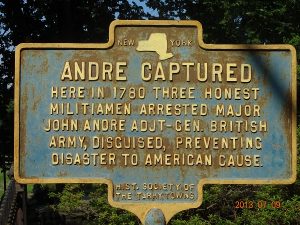
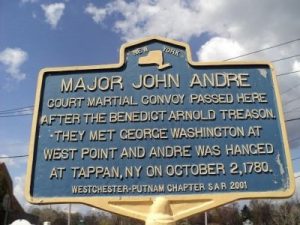
Tarrytown,Westchester County Carmel, Putnam County
(Courtesy Researching Librarian and The Historical Marker Database)
Has anyone ever heard of Elderhostel? It’s not as if New York State has to reinvent the wheel. Just do what has been done for decades elsewhere.
How come the non-tourist community-heritage program is even located in I Love NY.
Happy 4-year old birthday, Path through History. May your future take a turn for the better.





